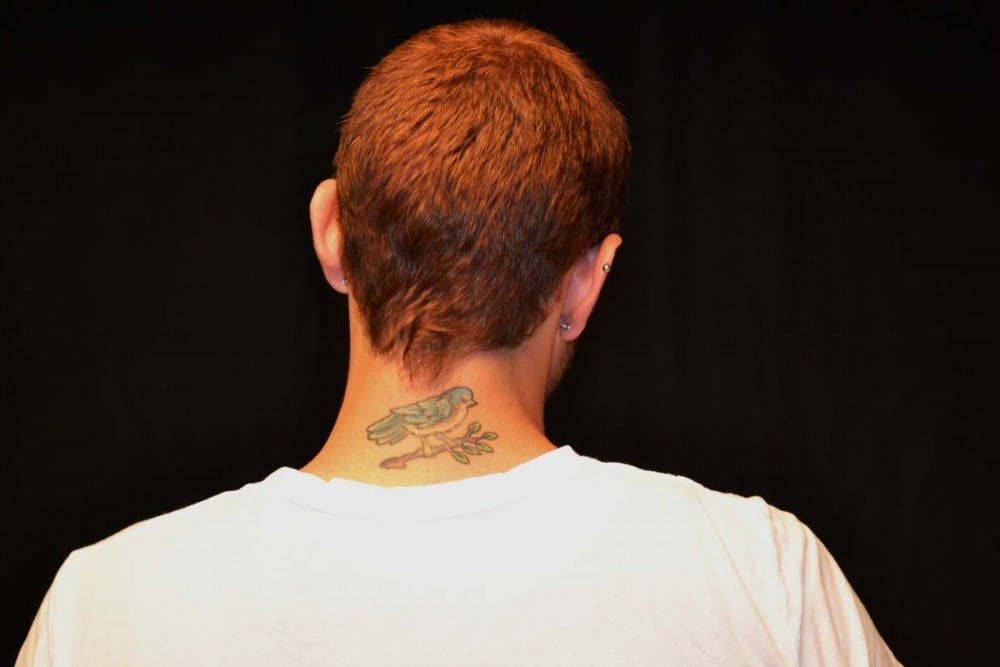Many students, professors, administrators and staff at Shippensburg University have something in common besides the fact that they attend, teach or work at the university.
Somewhere on their bodies they have a work of art in the form of a tattoo.
Tattoos have been gaining in popularity; something that can be attested to by the growing number of tattoo parlors in Shippensburg and surrounding towns.
Tattoos have been an expression of individuals since the early times. Maori people in Australia began inking extravagant blue tattoos over their faces and bodies. In India, henna designs over a soon-to-bride are customary. Although not permanent, the ink dyes the skin and for several days and even weeks later, the design is still evident.
Currently, many Americans get tattoos and there is a rising trend in designing one’s own tattoo or multiple pieces.
But why do it all?
Getting tattoos can be expensive and for some, very painful. There must be a reason why people eighteen and older continue to ink themselves up.
The phenomenon is no stranger to Shippensburg University’s campus where many students have some sort of body art, whether it is in a hidden place, such as the back, or visible, like an arm or leg.
Students on campus, like junior Stephanie Horvat, designed her own tattoo. Hers is blue stars on her hipbone.
Among the hardships of getting body art, SU students talked about the stigmas of putting the permanent ink on their body.
“My aunt told me, ‘you’ll never find a job,’” sophomore Ariel Welsh said.
Welsh has two tattoos; one on her foot of a heart with paw prints and the other of ‘Amore’ written on the inside of her wrist for her Italian heritage.
For others, the tattoo is a personal reminder of a loved one.
“Well, my tattoo, is the Chinese symbol for family. I got it because my stepsister, Khristen, died and it’s in memory of her,” sophomore Capri Morey said. She chose the design because, interestingly enough, the letter ‘K’ appears in the symbol.
Senior Erin Collins, chose to get a matching one with her best friend. Her tattoo reads ‘tres bien ensemble,’ a line in French from The Beatles song, “Michelle” and her best friend, Nicole Schools, has the same line tattooed on her lower back.
“We wanted to do something to commemorate our friendship,” she said. “Nikki has been like a sister to me.”
Others, like junior Benjamin Balutis, chose a symbol of what they love to do. Balutis, who has a bluebird and branch on the back of his neck, got the tattoo to represent his on-going love of poetry and writing.
“Nightingale’s are the trademark of a poet,” Balutis said. “But my poetry is a little different so I decided to get something a little different.”
The more they talked about their tattoos, the more animated and excited they got. The tattoos were more than a piece of art to show, they were figurative extensions of themselves.
Guerilla Tattoo, located in the town of Shippensburg, owner Mr. Boofman has been in business for five years and has seen his share of people getting tattooed.
His shop is located on West King Street, walking distance from the university. He averages out at tattooing about 8 people a day. He has also seen a lot of SU students in the shop.
“We get people from all walks of life,” Boofman said. “We see a lot of students and we get locals as well.”
But, why does he think that people get tattooed?
“It’s a form of expression,” Boofman said. “There are not many things in life you can buy that you can keep forever. It’s like, buying a piece of art is nice but they won’t be able to carry it with them.”
He also mentioned that a lot of people seem to get pieces done in memorial for lost ones.
As for a demographic of the type of people who decide to get tattoos, there does not seem to be an exact group.
“I’ve tattooed lawyers, grandmas and consultants,” Boofman said. He went on to talk about the age differences, with a large number being people in their twenties but described a rising number of people in their seventies coming in to get their first work done.
Five out of the six SU students plan to get more tattoos in the future.
“There is a community built up around tattoos,” Capri Morey said. “It’s like a society.”


The Slate welcomes thoughtful discussion on all of our stories, but please keep comments civil and on-topic. Read our full guidelines here.